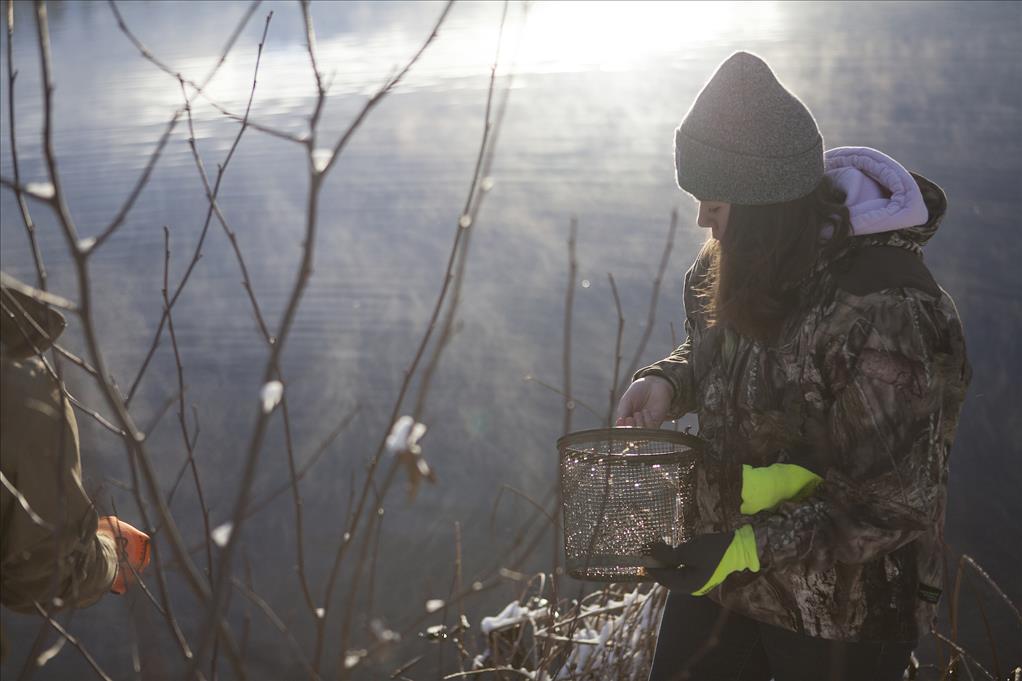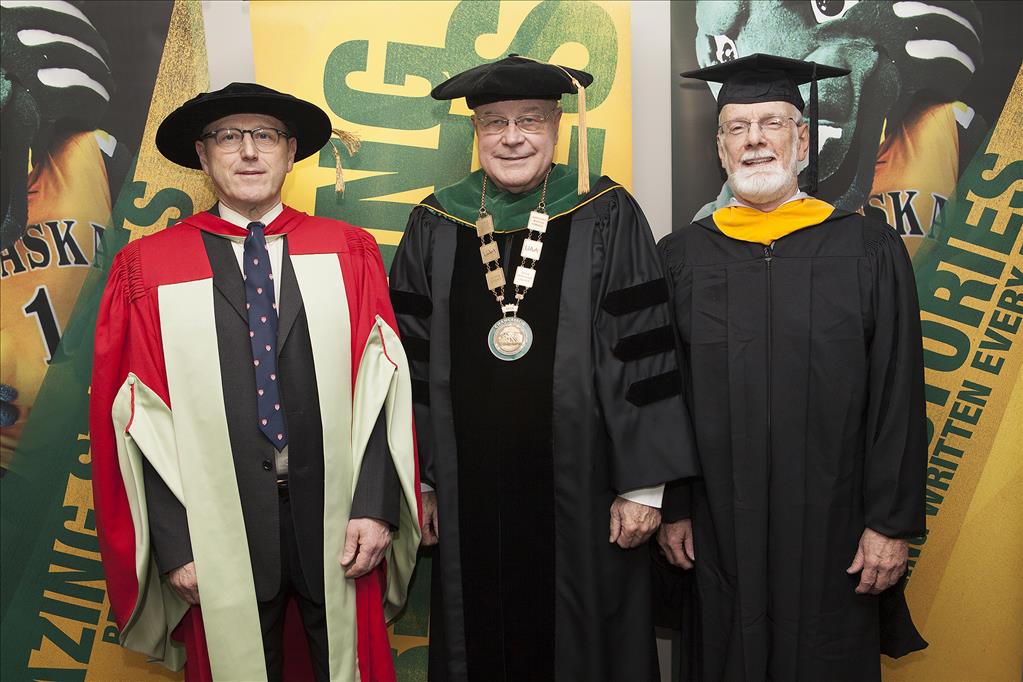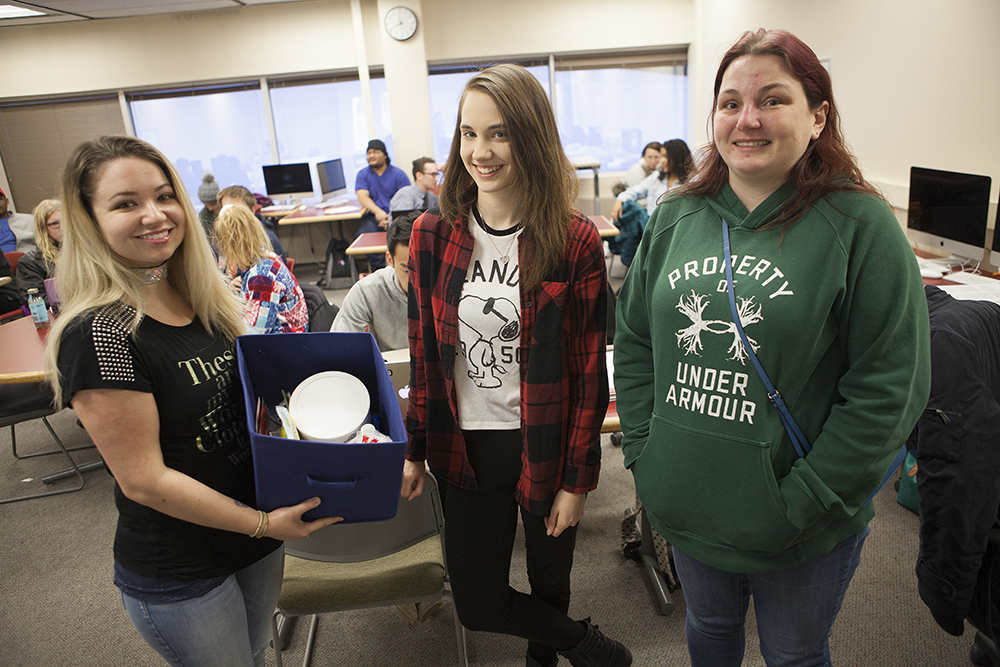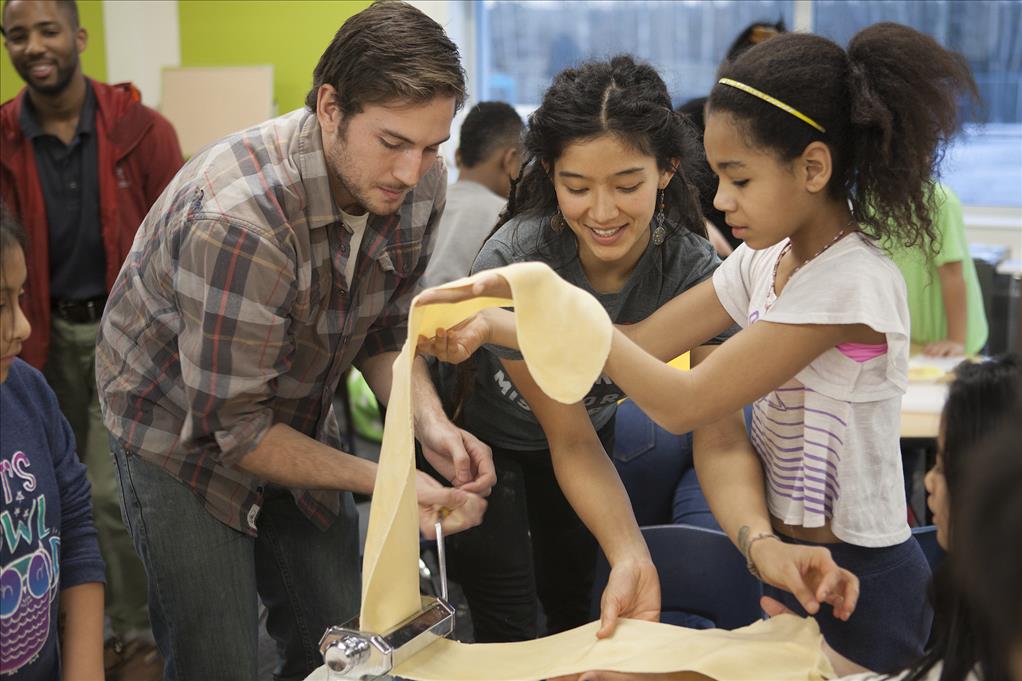Technical-writing students help Anchorage residents prepare for emergencies
by Tracy Kalytiak |

Three of Angela Andersen's technical-writing students — Delaney Smith, Kaleena Pysher and Latrisha Bednar — display an emergency-preparedness kit. Teams of students in Andersen's tech-writing classes, as an assignment, delivered presentations about emergency-preparedness to community councils throughout Anchorage. (Photo by Philip Hall / University of Alaska Anchorage)
If a massive earthquake slams Anchorage, wildfire rages toward homes or severe storms knock out power when temperatures have plunged below zero, it's vitally important for people to have supplies they need and follow a plan they created before the disaster.
Anchorage's Office of Emergency Management does all it can to draft big-picture response plans, coordinate resources and make information available through Nixle, Twitter, Facebook, and the OEM website.
Now, 99 students in Angela Andersen's four UAA technical writing classes are pitching in with "Help Everyone Learn Preparedness": Project HELP. Andersen tasked her students with researching Emergency Management's operations and plans and participating in its public outreach effort by offering disaster-preparedness presentations and neighborhood-specific response plans to Anchorage's 36 community councils.
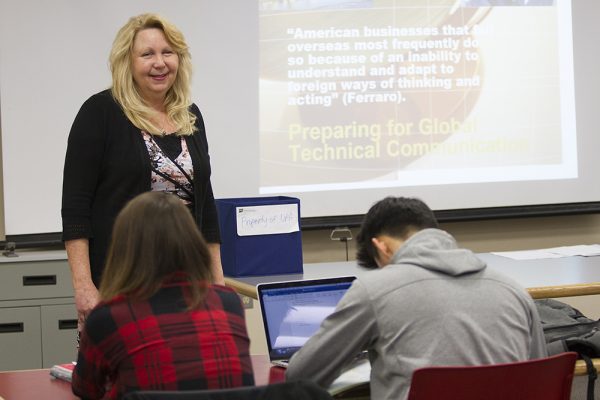
Angela Andersen teaches technical writing at UAA. She recently assigned her 99 students to tour the Anchorage Office of Emergency Management and then research Anchorage neighborhoods and meet with their respective community councils to devise disaster-preparedness plans and emergency kits. (Photo by Philip Hall / University of Alaska Anchorage)
"I saw a genuine need for neighborhood disaster preparedness in Anchorage and knew our talented UAA students could help fill that need by engaging in Project HELP," Andersen said. "The outcome has been marvelous: both the students and the Anchorage community councils are really beginning to catch the vision of preparedness."
Andersen drafted a faculty minigrant proposal for Project HELP, outlining how her students would devise PowerPoint presentations complete with training materials, speaker notes, images and video segments teaching residents to develop an individual or family emergency plan and emergency kit and develop a disaster mitigation plan for flood, fire, winter storms, earthquakes, and sheltering in place.
The students' neighborhood emergency plans, Andersen said, would establish neighborhood team roles; create an inventory of skills and expertise, equipment, and supplies; define gathering points and care sites; determine neighborhood special needs; analyze effective communication methods; help create and distribute contact lists; formulate mapping for home locations, care facilities and schools, and clarify ingresses and egresses within neighborhoods.
UAA's Center for Community Engagement & Learning approved Andersen's request, providing a grant that paid for disaster kits and covered the cost of the student bus transportation from UAA to the OEM for a tour.
"The students came to learn a little bit about what our office does, toured the office and the emergency operations center," said Julie Harvey, an OEM emergency programs manager. "They wanted to know what would I suggest that the community councils or the neighbors could do to become prepared."
Preventing disasters
One of Andersen's students, Trenton Drumm, devised a detailed, budget-friendly proposal for the Abbott Loop community, which is situated in an area that's at high risk for wildfires.
"The tasks that I created were to successfully take an uncontrolled landscape into a fire-resistant one," he wrote. "These tasks can help better protect the home from being destroyed in a blaze even if the fire burns the surrounding landscape. By implementing this plan, the community could save millions of dollars in property damages."
Drumm listed potential hazards — including burn barrels, gutters filled with moss and leaves, overhanging trees, dead vegetation, snowmachines and ATVs parked near homes. Using Anchorage Fire Department's Firewise program as a guide, Drumm recommended moving all combustibles at least 30 feet away and clearing away or pruning vegetation. The cost of a pruner, work gloves, spade shovel, tape measure and moss remover needed for the tasks, he estimated, would be less than $100.
Drum advised the council to adopt his plan in January, implement it in May and keep the plan active with yearly landscaping, updating the emergency kit and further fireproofing the neighborhood.
"By implementing this plan, your community will be able to go on with their lives, but also know that when the next disaster strikes, they will be ready," he wrote.
Student Hannah Crayton developed a disaster-response plan for the Basher neighborhood, detailing what each household should include in its emergency kit — a gallon of water per person, per day, for at least seven days; at least seven days' worth of nonperishable food; basic first-aid and pet supplies; clothing, bedding, sanitation supplies and tools; flashlights, radios and batteries. She also stressed the importance of getting to know the neighborhood and its residents.
"This is an important task because it allows you to learn of the resources you may have right down the street," she said, referring to neighbors with medical or law enforcement knowledge and experience that could be useful in an emergency.
Crayton reminded Basher neighbors to consider the needs of people who might need help during an emergency.
"This could include those with disabilities, the elderly, and families with small children," she said, providing a printable neighbor survey to assist in gathering that information.
"In the event of an emergency, an unorganized community can suffer greatly from their lack of planning and preparedness," Crayton said. "This plan is to be your trusted guide to a unified neighborhood."
Opening discussions
Students Cody Roan, Asai Kanako, Ethan Schmidt and Lucas Sosa, on Nov. 9, delivered their 20-minute presentation to the Russian Jack Community Council.
"We appreciated the presentation by the students — everyone learned something," said Ed Leach, RJCC president, in a follow-up note to Andersen. "Myself, while I have staged supplies for most emergencies (including 24 gallons of bleached water), I was forced to consider the danger of loss of natural gas for an extended period during the winter. ...Some of the information (such as winter clothing) may seem obvious to Alaskans, but it led to a discussion with school personnel about how they deal with immigrant children, for whose families this may be their first winter."
Information about wildland fires is critical for a hillside community where trees surround everyone living there.
"For councils in the Bowl," he said, "it would be more informative to detail what households adjacent to forest land — like 6th Avenue along Russian Jack Springs Park — should do to mitigate the hazard for themselves."
Written by Tracy Kalytiak, University of Alaska Anchorage
 "Technical-writing students help Anchorage residents prepare for emergencies" is licensed under a Creative Commons Attribution-NonCommercial 4.0 International License.
"Technical-writing students help Anchorage residents prepare for emergencies" is licensed under a Creative Commons Attribution-NonCommercial 4.0 International License.










